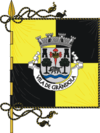Grândola
| Grândola | |||
|---|---|---|---|
| Municipality | |||
| |||
 | |||
| Coordinates: 38°10′N 8°34′W / 38.17°N 8.56°WCoordinates: 38°10′N 8°34′W / 38.17°N 8.56°W | |||
| Country |
| ||
| Region | Alentejo | ||
| Subregion | Alentejo Litoral | ||
| Intermunic. comm. | Alentejo Litoral | ||
| District | Setúbal | ||
| Parishes | 4 | ||
| Government | |||
| • President | Carlos Vicente Beato (CDU) | ||
| Area | |||
| • Total | 825.94 km2 (318.90 sq mi) | ||
| Population (2011) | |||
| • Total | 14,826 | ||
| • Density | 18/km2 (46/sq mi) | ||
| Time zone | WET/WEST (UTC+0/+1) | ||
| Website | http://www.cm-grandola.pt | ||
Grândola (Portuguese pronunciation: [ˈɡɾɐ̃dulɐ]) is a town (vila) and municipality in Setúbal District in Portugal. The population in 2011 was 14,826,[1] in an area of 825.94 km².[2]
Included in this municipality is Tróia (part of Carvalhal parish), a peninsula between the Atlantic Ocean and the Sado River. Also within the municipality is Serra de Grândola (Grândola Mountain). Nearest city: Alcácer do Sal.
The present mayor is Carlos Vicente Beato (Socialist), and the president of the Municipal Assembly is Aníbal Manuel Guerreiro Cordeiro (Socialist). The municipal holiday is October 22.
Grândola has its own railway station on the main line between Lisbon and Faro. Passenger trains are operated by Comboios de Portugal (CP).
Parishes
Administratively, the municipality is divided into four civil parishes (freguesias):[3]
- Azinheira dos Barros e São Mamede do Sádão
- Carvalhal
- Melides
- Grândola e Santa Margarida da Serra
Notable inhabitants
Gallery
 Landscape of Grândola
Landscape of Grândola Monument to the Carnation Revolution
Monument to the Carnation Revolution
See also
- "Grândola, Vila Morena" – a song by Zeca Afonso inspired by the Carnation Revolution
References
- ↑ Instituto Nacional de Estatística
- ↑ Direção-Geral do Território
- ↑ Diário da República. "Law nr. 11-A/2013, page 552 54" (pdf) (in Portuguese). Retrieved 23 July 2014.

